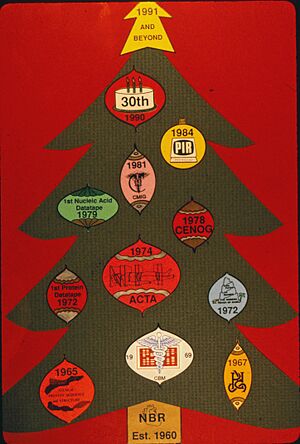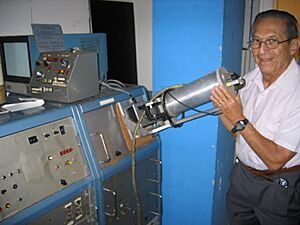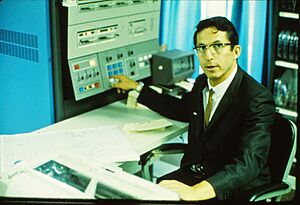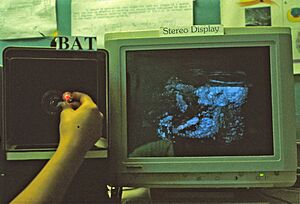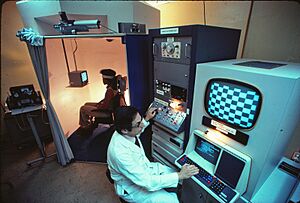Robert Ledley facts for kids
Quick facts for kids
Robert Ledley
|
|
|---|---|
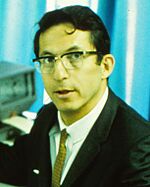
Robert Ledley
|
|
| Born | June 28, 1926 Flushing, Queens, New York, US
|
| Died | July 24, 2012 (aged 86) |
| Alma mater | |
| Known for |
|
| Spouse(s) | Terry Ledley (née Wachtell) |
| Awards |
|
| Scientific career | |
| Fields | mathematics, physics, computing, biology, medicine, dentistry |
| Institutions |
|
Robert Steven Ledley (June 28, 1926 – July 24, 2012) was a brilliant scientist. He taught at Georgetown University School of Medicine. He was a pioneer in using computers in biology and medicine.
In 1959, he wrote two important articles for Science magazine. These articles encouraged doctors and scientists to use computer technology.
In 1960, he started the National Biomedical Research Foundation (NBRF). This group helped use computers in medical research. At NBRF, Ledley worked on many big projects. He helped create the first whole-body CT scanner in the 1970s. He also helped manage the Atlas of Protein Sequence and Structure. This was a huge collection of information about proteins.
Ledley was recognized for his amazing work. In 1990, he joined the National Inventors Hall of Fame. He also received the National Medal of Technology in 1997. He retired from NBRF in 2010.
Contents
Robert Ledley's Early Life and Education
Robert Ledley was born on June 28, 1926, in Flushing, New York City. His father was an accountant, and his mother was a teacher. He had a sister, Marion, and a half-brother, Ralph.
One of Robert's childhood friends was Margaret Oakley Dayhoff. She later worked with him at the NBRF. She also helped create the field of bioinformatics. Robert went to the Horace Mann School and graduated in 1943.
Choosing a Career Path
Robert was very good at physics at Columbia University. He wanted to become a physicist. However, his parents worried there weren't many jobs in physics. They wanted him to become a dentist instead.
So, Robert tried to do both! He studied dentistry at New York University College of Dentistry. Then, he took the subway to Columbia for physics classes in the evenings. After becoming a dentist in 1948, he studied physics full-time. He learned from famous physicists like Enrico Fermi. He earned his master's degree in physics in 1950.
In 1949, Robert married Terry Wachtell. She was a math teacher. They had two sons, Fred and Gary. Terry later worked as a computer programmer. Both sons became doctors. Robert Ledley passed away in 2012 from Alzheimer's disease.
Robert Ledley's First Research Jobs
Improving Dental Devices for the Army
In 1950, during the Korean War, Robert joined the U.S. Army Dental Corps. Because he also knew physics, he worked in dental research. He helped make better dentures for soldiers.
He used his knowledge of dentistry and physics. He created a system to fit dentures perfectly. This system helped dentists find the best "angle of chew." His work even made headlines in newspapers!
Working with Early Computers
After the Army, Robert worked at the National Bureau of Standards in 1952. There, he found the Standards Eastern Automatic Computer (SEAC). This was one of the first electronic digital computers.
Robert learned to program SEAC from his wife, Terry. She was a programmer for the machine. He used SEAC for his dental research. Soon, he became an expert programmer. He worked on many projects, even a remote-controlled aircraft system!
Working with SEAC changed Robert's career. He realized computers could solve complex problems in medicine. He decided to dedicate his life to using computers in biomedical research.
Helping Doctors Use Computers
In 1959, Ledley and Lee B. Lusted published a famous article. It was called "Reasoning Foundations of Medical Diagnosis." It taught doctors how to use new computer methods. They showed how to use symbolic logic and probability.
They hoped computers would make doctors' work easier. They also believed computers could help avoid human errors. This article was very important for medical decision-making.
Ledley and Lusted even imagined a national network of medical computers. This was long before the internet! It would allow doctors to share patient records. It would also help analyze health data quickly.
Encouraging Computer Use in Science
In 1957, Ledley surveyed how computers were used in biology and medicine. He published his findings in a 1959 Science article. He urged biologists to learn math and engineering. This would help them use computers better.
His survey helped the National Institutes of Health (NIH). In 1960, Congress gave the NIH $40 million. This money was to encourage computer use in medical research. Ledley's ideas guided this effort.
The National Biomedical Research Foundation (NBRF)
Starting the NBRF
After his survey, Robert Ledley wanted to do more. In 1960, he started the National Biomedical Research Foundation (NBRF). It was a nonprofit organization. He left his university job to lead it full-time.
The NBRF wanted to show scientists how computers could improve biology and medicine. It started small but grew quickly. It received money from the NIH and other sources.
In 1970, the NBRF moved to Georgetown University Medical Center. Robert Ledley became a professor there. The NBRF provided computing resources for the university.
FIDAC: Recognizing Patterns in Images
One of NBRF's first big projects was optical pattern recognition. Ledley and his team built the Film Input to Digital Automatic Computer (FIDAC) in the 1960s.
FIDAC could scan photos into a computer. It would then recognize patterns in the image. It worked by turning parts of a photo into numbers. It could scan a large image in less than half a second!
Ledley designed FIDAC to analyze chromosomes. This helped detect conditions like Down syndrome. FIDAC could do a chromosome analysis in 40 seconds. A human technician took 15 minutes! FIDAC was also used to analyze neurons and Pap smears.
To help people discuss this technology, Ledley started a journal. It was called Pattern Recognition. He was its editor until 2010.
ACTA: The First Whole-Body CT Scanner

Robert Ledley is most famous for developing the CT scanner. This work began in 1973. Georgetown University wanted a CT scanner, but they were very expensive. Ledley promised to build one for half the price.
The NBRF team wanted to improve existing CT scanners. Older scanners needed a water tank around the patient's head. Ledley's team found a way to remove this. They changed the math used to create the image.
In 1974, Ledley's team finished the Automatic Computerized Transverse Axial (ACTA) scanner. It was much faster than other scanners. Most importantly, ACTA could scan the entire body. Other scanners could only scan the head.
ACTA was a huge success. A doctor at Georgetown used it to find brain bleeding in a child. This helped save the child's life. News spread quickly, and people worldwide wanted ACTA machines.
Ledley started a company called DISCO to sell ACTA scanners. He received a patent for ACTA's design in 1975. The ACTA prototype is now displayed at the National Museum of American History.
Bioinformatics: Understanding Proteins
Ledley's colleague, Margaret Oakley Dayhoff, worked on bioinformatics. In 1965, she created the Atlas of Protein Sequence and Structure. This was a huge collection of data about protein sequencing.
The Atlas was published every year. It started as a book, then became magnetic tapes, and later CD-ROMs. It was a key resource for scientists studying proteins. It also inspired other important biological databases.
After Dayhoff passed away in 1983, Ledley continued her work. He and his team created the Protein Information Resource (PIR). This was an online version of the Atlas. Scientists could access it using modems. Today, PIR is still an important resource for biologists.
Other NBRF Computer Projects
From 1979 to 1980, Ledley developed the Computerized Electro Neuro Ophthalmograph (CENOG). This machine could automatically analyze eye movements. This helped doctors diagnose brain and eye problems.
Ledley also thought about future computer design. In 1970, he wrote about a "Billion-Gate Computer." He imagined a computer with a billion logic gates. He thought it could redesign its own parts and even "self-heal." Today, computers with billions of transistors are common!
In the late 1980s, Ledley's team created the Bat. This was a 3-D mouse. It allowed users to interact with objects in 3-D computer images.
Awards and Recognition
Robert Ledley received many honors for his contributions:
- Morris F. Collen Award, American College of Medical Informatics (AMIA) (1998)
- National Inventors Hall of Fame (inducted 1990)
- National Medal of Technology (1997)
- Vicennial Gold Medal for Distinguished Service, Georgetown University (1990)
- Member, Institute of Medicine, National Academy of Sciences (1999)
- Distinguished Alumnus, New York University (1999)



